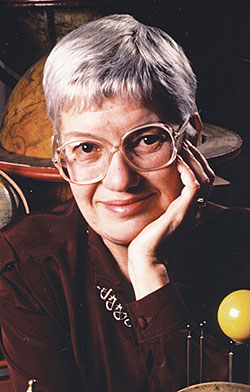Vera Cooper Rubin
DOI: 10.1063/PT.3.3503
Vera Cooper Rubin, who transformed our understanding of the universe by confirming the existence of dark matter, passed away on 25 December 2016 in Princeton, New Jersey. A trailblazing astronomer, a passionate champion of women in science, and an inspiring role model to generations of scientists, Rubin was loved and admired by her many colleagues and friends.

Vera Cooper Rubin
MARK GODFREY

Born in Philadelphia on 23 July 1928, Rubin moved with her family to Washington, DC, when she was 10. She developed her love for astronomy at an early age as she watched the stars go by, built a telescope, and wondered about the mysteries of the universe. She graduated with a bachelor’s degree in astronomy from Vassar College in 1948. That year, at 19, she married Robert Rubin, a chemistry PhD student at Cornell University, and joined him there for her master’s degree in astronomy.
In 1951 they moved back to DC, where Rubin began her PhD at Georgetown University with legendary physicist George Gamow. Her thesis explored the spatial distribution of galaxies. She found that the galaxy distribution was clumped rather than randomly distributed in space—a surprising and important result whose significance took years to fully appreciate. Rubin earned her PhD in 1954 and remained at Georgetown to teach.
In 1965 she joined the department of terrestrial magnetism (DTM) at the Carnegie Institution of Washington. Rubin thrived at the DTM for the rest of her career. She carried out her seminal work there and mentored generations of budding astronomers. Said current Carnegie president Matthew Scott, “Vera Rubin was a national treasure as an accomplished astronomer and a wonderful role model for young scientists.”
Rubin’s groundbreaking scientific contribution was establishing the flat rotation curves of spiral galaxies: She showed that stars orbit the galactic center with velocities that remain constant (flat) out to the outer parts of galaxies rather than decline with distance, as expected from Newtonian gravity. The higher-than-expected velocity at the outskirts implies more mass than can be accounted for by stars and gas. Those findings provided crucial evidence for the existence of dark matter—a suggestion first made by Fritz Zwicky in 1933 and based, similarly, on his observing unexpectedly high velocities of galaxies in galaxy clusters. Rubin’s flat rotation curves implied that galaxies are embedded in large dark-matter halos.
Rubin’s work was carried out in close collaboration with her long-time DTM colleague Kent Ford. An outstanding astronomy instrumentalist, Ford built the sophisticated DTM image-tube spectrograph—the first electronic optical detector in astronomy—which enabled the precise measurements of galactic rotations. The historic instrument is now permanently located at the National Air and Space Museum in Washington, DC.
Rubin and Ford’s first rotation curve, in 1970, was of our nearby Andromeda galaxy. Over the next decade, they observed a large number of spiral galaxies that all revealed the same remarkable flat rotation curves. Around the same time, Morton Roberts and others found similar flat rotation curves for the hydrogen gas disks that surround spiral galaxies. Both sets of observations were critical in establishing the need for dark matter—and forever changing our view of the universe.
We now know that 85% of the mass in the universe is dark matter; it profoundly affects the evolution of the universe and the formation of cosmic structure. The dark matter is believed to be a new nonbaryonic particle, not yet detected by direct experiments. Asked frequently about whether the flat rotation curves could instead be due to deviations from Newtonian gravity, Rubin was agnostic: “I don’t know if we have dark matter or need a change in gravity or need something else; we know so little about our universe. It is a strange and mysterious universe. But that’s fun.”
Rubin continued working on galaxy dynamics and large-scale structure throughout her career. Among her discoveries were counterrotating galaxies, which exhibit stars orbiting clockwise as well as counterclockwise; polar-ring galaxies; and merging galaxies.
Rubin’s personal story, including the challenges she faced as a woman in science, is told in a 2011 autobiographical article in Annual Reviews of Astronomy and Astrophysics. When she was applying for college, an interviewer suggested she consider a career painting astronomical objects instead of doing research. She was denied observing time on the 200-inch Hale Telescope at Palomar Observatory until the mid 1960s, when women were finally allowed access to it. “Don’t let anyone keep you down for silly reasons,” she advised young colleagues. “Do what you love doing.” She passionately supported women scientists: “There is no problem in science that can be solved by a man that cannot be solved by a woman,” she would often say.
Cheerful, positive, and kind, Rubin enjoyed a remarkable life. She and her husband of 60 years raised four children, three of whom became scientists and the fourth a mathematician. Her love of the cosmos was infectious: “How could you possibly live on this Earth and not want to study the universe?” she asked. And so she did.
Rubin’s seminal accomplishments have been recognized by numerous awards, including the US National Medal of Science in 1993, the 1996 Gold Medal of the Royal Astronomical Society, the Gruber Cosmology Prize in 2002, and the National Academy of Sciences James Craig Watson Medal in 2004. The Nobel Committee for Physics and the Royal Swedish Academy of Sciences failed to honor her and her vital contribution, as they failed to recognize other important discoverers. But Rubin’s legacy as a pioneer of flat rotation curves and dark matter and as a role model to generations of scientists will forever be remembered.
More about the Authors
Neta A. Bahcall. Princeton University, Princeton, New Jersey.
